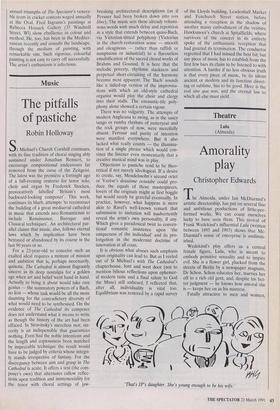Music
The pitfalls of pastiche
Robin Holloway
St Michael's Church Cornhill continues, with its fine tradition of choral singing ably sustained under Jonathan Rennert, to encourage compositional endeavours far removed from the curse of the Zeitgeist. The latest was the premiere a fortnight ago of a full-evening oratorio for tenor solo, choir and organ by Frederick Stocken, provocatively labelled 'Britain's most backward-looking composer'. This work, continues its blurb, attempts 'to reconstruct the building of a great mediaeval cathedral in music that extends neo-Romanticism to include Renaissance, Baroque and Classical techniques'. An architectural par- allel claims that music, also, follows eternal laws which by implication have been betrayed or abandoned by its course in the last 90 years or so.
For a 23-year-old to conceive such an exalted ideal requires a mixture of mission and ambition that is, perhaps necessarily, quixotic. The Cathedral is almost flagrantly sincere in its deep nostalgia for a golden age when art and belief went hand in hand. Actually to bring it about would take rare genius — the summatory powers of a Bach, no less — whose task would be all the more daunting for the contradictory diversity of what would need to be synthesised. On the evidence of The Cathedral its composer does not understand what it means to write as though the history of the art had been effaced. In Stravinsky's merciless mot, sin- cerity is an indispensible that guarantees nothing. Even had the noble intentions and the length and copiousness been matched by impeccable technique the result would have to be judged by criteria whose integri- ty stands irrespective of fantasy. For the discrepancy between aim and grasp in The Cathedral is acute. It offers a text (the com- poser's own) that alternates callow reflec- tions upon tradition and immemoriality for the tenor with choral settings of jaw- breaking architectural descriptions (as if Pevsner had been broken down into vers libre). The music sets these already volumi- nous words with much delay and repetition in a style that extends between quasi-Bach, via Victorian-tinted polyphony (Victorian in the church-restoration sense — smooth and oleaginous — rather than raffish or sumptuous or industrial) to a flavourless emulsification of the sacred choral works of Brahms and Gounod. It is here that the melodic poverty, rhythmic slackness and perpetual short-circuiting of the harmony become most apparent. The 'Bach' sounds like a tidied-up version of the improvisa- tions with which an old-style cathedral organist would play the choir and clergy into their stalls. The encaustic-tile poly- phony alone showed a certain vigour.
There was no vulgarity. The attempts of modern Anglicana to swing, as in the saucy tango or rumba rhythms of yesteryear and the rock groups of now, were mercifully absent. Fervour and purity of intention were manifest everywhere. But it also lacked what really counts — the illumina- tion of a single phrase which would con- vince the listener even momentarily that a creative musical mind was in play.
Objections to pastiche tend to be theo- retical if not merely ideological. If a desire to create, say, Mendelssohn's second octet or Varese's dewcieme octandre could pro- duce the equals of those masterpieces, lovers of the originals might at first boggle but would surely be grateful eventually. In practice, however, what happens is more akin to Ravel's well-known remark that submission to imitation will inadvertently reveal the artist's own personality, if any. Which gives a paradoxical twist to conven- tional romantic insistence upon 'the uniqueness of the individual' and its pro- longation in the modernist doctrine of innovation at all costs.
It is obvious what abuses such emphasis upon originality can lead to. But as I reeled out of St Michael's with The Cathedral's chapterhouse, font and west door (not to mention bilious reflections upon ephemer- al modern taste and a final salute to God the Muse) still unheard, I reflected that, after all, individuality is vital too. Equilibrium was restored by a rapid survey 'That's JP's daughter. She's young enough to be his wife.' of the Lloyds building, Leadenhall Market and Fenchurch Street station, before attending a reception in the shadow of another massy embodiment of the verities, Hawksmoor's church at Spitalfields, where survivors of the concert in its entirety spoke of the enthusiastic reception that had greeted its termination. The conductor regretted that I had missed the best bit; but any piece of music has to establish from the first few bars its claim to be listened to with attention. A harder if no less obvious truth is that every piece of music, be its idiom ancient or modern and its function divert- ing or sublime, has to be good. Here is the real sine qua non, and the eternal law to which all else must yield.


























































 Previous page
Previous page